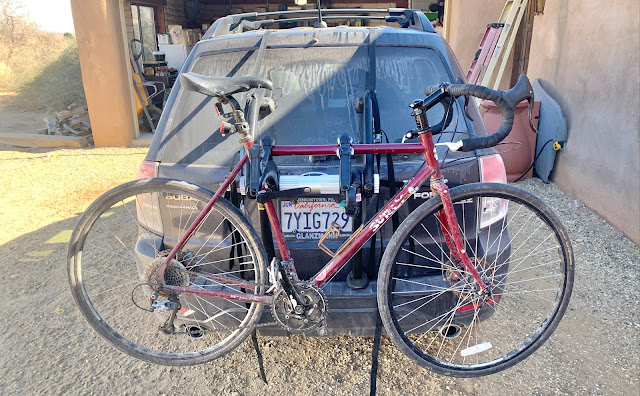Regular readers know that Sonia and I are traveling the US for at least the first half of 2022, but I haven't revealed our exact motivation/purpose until now! Our plan to exchange pet-sitting for lodging while home/owners travel might sound insane, but www.trustedhousesitters.com allows people to do exactly that. I kept this news on the down-low until now because Sonia and I wanted to get a second blog, A Tail of Two Sitters, up and running before we let the cat/dog/whatever out of the bag. While we have a loose itinerary of places/states we'd like to visit in upcoming months, we're generally going to allow the pet-sitting winds take us where they will. And that's how we landed in Henderson, NV from January 13-16. I did a bit of birding while we were in the area, most of it by bike, and I'll use this post to highlight some of the places I visited. Here's how we're carting the bike around!
Among three Henderson sites which I visited on my bike, the Henderson Bird Preserve on the east side of town was the best. The impoundments hosted a great number and variety of waterfowl, and desert birds like Costa's Hummingbird, Crissal Thrasher, Vermillion Flycatcher, Black-tailed Gnatcatcher, and Abert's Towhee lurked in the surrounding bushes. Over 300-species have been recorded at the reserve, and I tallied 60 across two morning visits, a breeding plumage Hooded Warbler an unlikely highlight. Beware - the HBP has very strict hours. Please consult this webpage for info. If I had only one morning to bird in the Las Vegas area, the I'd use it at HBP. Images of reserve below.
Neighboring Clark County Wetlands hosts similar species, but not in the same numbers as HBP. A series of trails winds through scrub and impoundments, and I think it's worth a quick pass even if it's a distant second to HBP. Same for Sunset Park. Though urban and heavily-visited, the park pond was loaded with waterfowl. The ducks are fed constantly, so super close views of Ring-necked Ducks, Canvasbacks, Redheads, Lesser Scaup, and American Wigeon were afforded. I hit the place on a cloudy afternoon, but it could be great for photography in the right conditions. Here is a map to show the relative locations of these HBP, CC Wetlands, and Sunset Park. It was easy to move between the three locations on the bike given our central location.
A bit farther afield, Red Rock Canyon on the west side of Las Vegas is totally worth a visit. It doesn't hold diversity or numbers of birds, but the landscape is amazing. There are loads of trails, and it would be easy to spend a full day exploring the area. The two dogs which we were watching loved scrambling over the stratified geology! Birds were few and far between, but I did find Rock Wren, Phainopepla, and Peregrine Falcon.
The bottom line is that there's an unexpected amount of birding and hiking to be done in the greater Las Vegas Area. While most who visit the city do so for other reasons, birders and outdoor enthusiasts will find plenty to occupy themselves over a three- or four-day stay.











